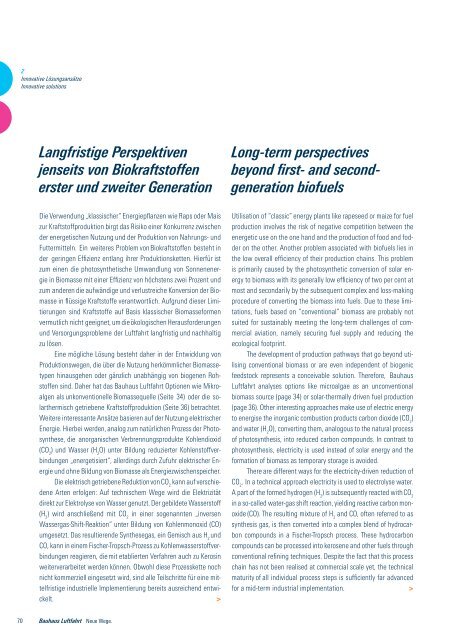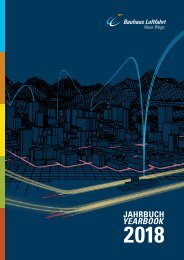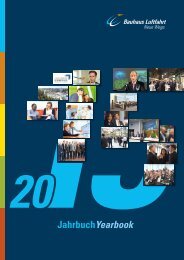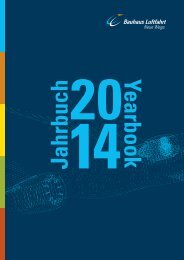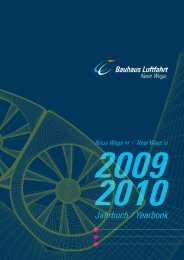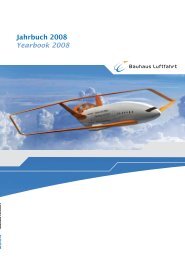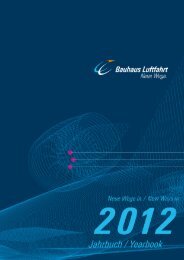o_190b92ptg1anf1eaka0f1i7s1foba.pdf
Sie wollen auch ein ePaper? Erhöhen Sie die Reichweite Ihrer Titel.
YUMPU macht aus Druck-PDFs automatisch weboptimierte ePaper, die Google liebt.
2<br />
Innovative Lösungsansätze<br />
Innovative solutions<br />
Langfristige Perspektiven<br />
jenseits von Biokraftstoffen<br />
erster und zweiter Generation<br />
Long-term perspectives<br />
beyond first- and secondgeneration<br />
biofuels<br />
Die Verwendung „klassischer“ Energiepflanzen wie Raps oder Mais<br />
zur Kraftstoffproduktion birgt das Risiko einer Konkurrenz zwischen<br />
der energetischen Nutzung und der Produktion von Nahrungs- und<br />
Futtermitteln. Ein weiteres Problem von Biokraftstoffen besteht in<br />
der geringen Effizienz entlang ihrer Produktionsketten. Hierfür ist<br />
zum einen die photosynthetische Umwandlung von Sonnenenergie<br />
in Biomasse mit einer Effizienz von höchstens zwei Prozent und<br />
zum anderen die aufwändige und verlustreiche Konversion der Biomasse<br />
in flüssige Kraftstoffe verantwortlich. Aufgrund dieser Limitierungen<br />
sind Kraftstoffe auf Basis klassischer Biomasseformen<br />
vermutlich nicht geeignet, um die ökologischen Herausforderungen<br />
und Versorgungsprobleme der Luftfahrt langfristig und nachhaltig<br />
zu lösen.<br />
Eine mögliche Lösung besteht daher in der Entwicklung von<br />
Pro duktionswegen, die über die Nutzung herkömmlicher Biomassetypen<br />
hinausgehen oder gänzlich unabhängig von biogenen Rohstoffen<br />
sind. Daher hat das Bauhaus Luftfahrt Optionen wie Mikroalgen<br />
als unkonventionelle Biomassequelle (Seite 34) oder die solarthermisch<br />
getriebene Kraftstoffproduktion (Seite 36) betrachtet.<br />
Weitere interessante Ansätze basieren auf der Nutzung elektrischer<br />
Energie. Hierbei werden, analog zum natürlichen Prozess der Photosynthese,<br />
die anorganischen Verbrennungsprodukte Kohlendioxid<br />
(CO 2<br />
) und Wasser (H 2<br />
O) unter Bildung reduzierter Kohlenstoffverbindungen<br />
„energetisiert“, allerdings durch Zufuhr elektrischer Energie<br />
und ohne Bildung von Biomasse als Energiezwischenspeicher.<br />
Die elektrisch getriebene Reduktion von CO 2<br />
kann auf verschiedene<br />
Arten erfolgen: Auf technischem Wege wird die Elektrizität<br />
direkt zur Elektrolyse von Wasser genutzt. Der gebildete Wasserstoff<br />
(H 2<br />
) wird anschließend mit CO 2<br />
in einer sogenannten „inversen<br />
Wassergas-Shift-Reaktion“ unter Bildung von Kohlenmonoxid (CO)<br />
umgesetzt. Das resultierende Synthesegas, ein Gemisch aus H 2<br />
und<br />
CO, kann in einem Fischer-Tropsch-Prozess zu Kohlenwasserstoffverbindungen<br />
reagieren, die mit etablierten Verfahren auch zu Kerosin<br />
weiterverarbeitet werden können. Obwohl diese Prozesskette noch<br />
nicht kommerziell eingesetzt wird, sind alle Teilschritte für eine mittelfristige<br />
industrielle Implementierung bereits ausreichend entwickelt.<br />
><br />
Utilisation of “classic” energy plants like rapeseed or maize for fuel<br />
production involves the risk of negative competition between the<br />
energetic use on the one hand and the production of food and fodder<br />
on the other. Another problem associated with biofuels lies in<br />
the low overall efficiency of their production chains. This problem<br />
is primarily caused by the photosynthetic conversion of solar energy<br />
to biomass with its generally low efficiency of two per cent at<br />
most and secondarily by the subsequent complex and loss-making<br />
procedure of converting the biomass into fuels. Due to these limitations,<br />
fuels based on “conventional” biomass are probably not<br />
suit ed for sustainably meeting the longterm challenges of commercial<br />
aviation, namely securing fuel supply and reducing the<br />
ecological footprint.<br />
The development of production pathways that go beyond utilising<br />
conventional biomass or are even independent of biogenic<br />
feedstock represents a conceivable solution. Therefore, Bauhaus<br />
Luft fahrt analyses options like microalgae as an unconventional<br />
bio mass source (page 34) or solar-thermally driven fuel production<br />
(page 36). Other interesting approaches make use of electric energy<br />
to energise the inorganic combustion products carbon dioxide (CO 2<br />
)<br />
and water (H 2<br />
O), converting them, analogous to the natural process<br />
of photosynthesis, into reduced carbon compounds. In contrast to<br />
photosynthesis, electricity is used instead of solar energy and the<br />
formation of biomass as temporary storage is avoided.<br />
There are different ways for the electricity-driven reduc tion of<br />
CO 2<br />
. In a technical approach electricity is used to electrolyse water.<br />
A part of the formed hydrogen (H 2<br />
) is subsequently reacted with CO 2<br />
in a so-called water-gas shift reaction, yielding reactive car bon monoxide<br />
(CO). The resulting mixture of H 2<br />
and CO, often re ferred to as<br />
synthesis gas, is then converted into a complex blend of hydrocarbon<br />
compounds in a Fischer-Tropsch process. These hydrocarbon<br />
compounds can be processed into kerosene and other fuels through<br />
conventional refining techniques. Despite the fact that this process<br />
chain has not been realised at commercial scale yet, the technical<br />
maturity of all individual process steps is suf ficiently far advanced<br />
for a mid-term industrial implementation.<br />
><br />
70<br />
Bauhaus Luftfahrt Neue Wege.


